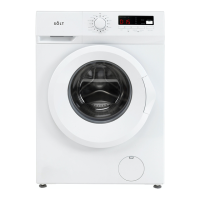10 11
Operating Instructions
PREPARATION BEFORE WASHING CLOTHES
Please follow these steps carefully to avoid trouble with your washing machine and damaging your clothing.
Washing Considerations
• New clothes in particular, can leach colour onto other
clothing items, particularly whites.
Consider washing these and bright colours separately.
• Stained clothing should be treated with a stain
remover, prior to washing.
• Temperature sensitive clothes should be washed in
accordance with their care direction label. Otherwise
distortion and/or changes in colour could occur.
• Never allow washing to sit in the machine for a long
period of time- particularly when wet. Clothes can
become mouldy and develop an odour.
• Certain clothing cannot be washed in a washing
machine and their care directions may state dry
cleaning or hand washing required.
• Wrinkle style clothes, embossed clothes, resin clothes,
etc may become distorted when immersed in water.
• Avoid washing clothes without care direction labels
within the appliance, to be safe.
• Always remove all items from clothing pockets, as hard
items can cause damage to the appliance.
• Try to wash clothing colours and sizes in like loads,
as this will improve the eectiveness of the washing
and results.
• Close all clothing zips and ensure all buttons are
fastened securely.
• Delicate items such as bras, handkerchiefs and ties
should be washed within a special washing bag, to
prevent damage to themselves and other clothes.
• When washing a large single item that could become
heavy (i.e. a towel or jacket), it can cause the appliance
to become unbalance during its spin cycle. Therefore
it’s recommended to add one or two more clothing
items to help the machine balance.
• Try to remove any pet hair, dust and stains from
clothing prior to washing.
• Baby clothing should be washed separately.
• Clothing that gets easily “fuzzed” or loses bres easily,
should be washed separately.
• Black clothing items should be washed separately.
• Do not wash waterproof materials within the
washing machine.
Pay Attention to Detergents
• Only use suitable front load washing machine
detergents with this appliance. Powders and liquid
detergents only.
• Only ever use the recommended quantity of detergent,
as per the manufacturer’s guidelines, as an excessive
quantity can cause excessive bubbles and overow to
occur.
• It can also result in detergent residue remaining on the
clothing after completion of the wash cycle.
WARNING: Always keep detergents and additives out
of reach from children.
Clothing Classications
The symbol types on care labels are typically classied
into the following textiles: Cotton, Blended Fiber, Synthetic
Fiber, Silk, Wool and Articial Fiber.
Conrm the Washing Capacity
Never load the machine with excessive weights, as it will
aect your washing results.
Fiber type Maximum Load Capacity
Cotton
6.0kg
Synthetics
3.0kg
Wool
2.0kg
Delicates
2.5kg
WASHING CLOTHES FOR THE FIRST TIME
Before washing any clothes, please perform one cycle
without clothes inside as follows:
• Connect the power source and water.
• Insert a small amount of detergent into Compartment II
of the detergent drawer and close it.
• Select the desired program.
• Press the “Start/Pause” button on the appliance.
• Allow the program to complete and your washing
machine is now ready for use.
SELECTING A PROCEDURE
You should select you washing program based on the type
of clothing, quantity and dirtiness level, in combination
with the following temperature table.
Temperature Mode Application
90ºC
Seriously soiled clothing, pure white cotton
(I.e. bed linen, towels, table cloths, etc)
60ºC
Moderately soiled clothing, cotton and
synthetic articles with certain decolourising
degree (I.e. shirts, pyjamas, etc)
40ºC, 30ºC,
20ºC, Cold Water
Lightly soiled clothing, synthetics and wool
To select a program:
• First turn the Program Selection Dial to the
corresponding wash program, according to the type
of textiles being washed.
• Secondly, select the desired temperature based on
the level of dirtiness.
Note: Generally the higher the temperature, the more
power that’s consumed.
• Finally, select your desired spin speed. The higher the
spin speed, the drier the textiles will be at completion,
however more delicate textiles will be more wrinkled.
Delicate textiles should be set with a lower spin speed.
Selecting the main washing program depend on the types
of clothing to be washed, as follows:
Cotton Eco
This procedure saves energy and limits the washing
temperature to 40°C or 60°C. Use with a small quantity of
clothes which are only lightly dirty.
Cotton
To increase the washing results, the main washing time
is increased. It is recommended for washing clothes for
babies or worn by the persons with skin allergies. It is
recommended for washing durable cotton articles, for
example: bed sheets, quilt covers, pillowcases, gowns,
underwear, etc.
Synthetic
The procedure is shorter compared with that for cottons
and the washing intensity is relatively gentle. It is
recommended for washing synthetic articles, for example:
shirts, coats, etc.
Mix
For loads with mixed textiles made of cottons and
synthetics.
Delicate
You can select this procedure to wash your delicate
clothes. Its washing intensity is gentler and spin speed
is low compared with the “Synthetic” procedure. It is
recommended for washing any articles requiring a soft
wash.
Jeans
This reduces the wear and tear on your jeans.
Jeans
Protecting your colours better, wash brightly coloured
clothes using this procedure
Spin Only
This procedure provides a spin only option. Residual soapy
water shall be drained out before spinning.
Rinse & Spin
This procedure provides a short rinse cycle followed by a
spin cycle.
Baby Care
Washing the baby’s clothes, it can make the baby’s wear
cleaner and make the rinse performance better to protect
the baby skin.

